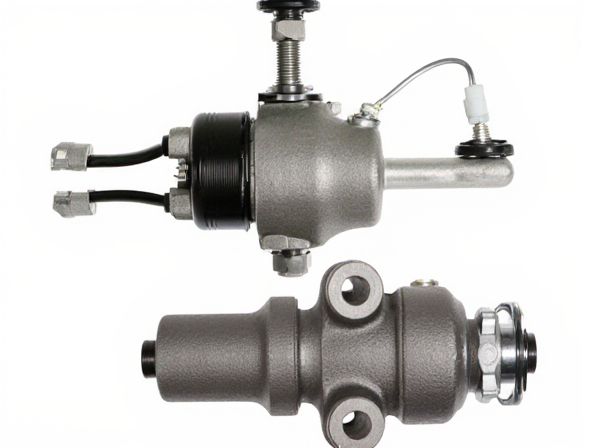
Photo illustration: Manual Steering Box vs Power-Assisted Steering Box
Manual steering boxes provide direct mechanical control over vehicle steering, requiring more physical effort from the driver, especially at low speeds or during parking. Power-assisted steering boxes use hydraulic or electric systems to reduce the effort needed, enhancing steering responsiveness and comfort. Your choice between the two depends on preferences for driving feel, ease of control, and vehicle type.
Table of Comparison
| Feature | Manual Steering Box | Power-Assisted Steering Box |
|---|---|---|
| Steering Effort | High, requires more physical strength | Low, easier to steer with hydraulic or electric aid |
| Complexity | Simple mechanical design | Complex system with hydraulic pump or electric motor |
| Cost | Lower initial cost, less maintenance | Higher initial cost, increased maintenance expenses |
| Steering Feedback | Direct road feel, better feedback | Reduced feedback due to assist mechanisms |
| Reliability | Highly reliable, less prone to failure | Potential for hydraulic or electric system failure |
| Fuel Efficiency Impact | No impact on fuel consumption | Minor increase in fuel usage with hydraulic systems |
| Use Cases | Classic cars, off-road vehicles, low budget | Modern vehicles, luxury cars, ease of driving |
Introduction to Steering Systems
Steering systems in vehicles primarily consist of manual steering boxes and power-assisted steering boxes, each offering distinct operational mechanisms and driver experiences. Manual steering boxes rely solely on the driver's physical effort to turn the wheels, providing direct feedback and simplicity but requiring more strength, especially at low speeds. Power-assisted steering boxes incorporate hydraulic or electric systems to reduce steering effort, enhancing maneuverability and comfort without compromising control precision.
Understanding Manual Steering Boxes
Manual steering boxes rely solely on driver input to turn the wheels, offering direct feedback and greater mechanical simplicity without hydraulic or electric assistance. This system is lighter and less complex, making it more durable and easier to maintain but can require more physical effort, especially at low speeds or when parking. Understanding manual steering boxes is crucial for appreciating their role in classic vehicles and specialized applications where precise steering feel and reliability are prioritized.
What Is a Power-Assisted Steering Box?
A power-assisted steering box is a vehicle control mechanism that reduces the driver's effort needed to turn the steering wheel by using hydraulic or electric power assistance. Unlike a manual steering box, which relies solely on mechanical linkages and driver strength, the power-assisted version incorporates a pump or motor to amplify steering inputs for smoother and easier maneuvering. This system enhances driving comfort, especially at low speeds and during tight turns, improving overall vehicle control and safety.
Key Differences Between Manual and Power-Assisted Steering
Manual steering boxes require direct physical effort from the driver to turn the wheels, relying on mechanical linkages without hydraulic or electric assistance. Power-assisted steering boxes incorporate hydraulic or electric systems that reduce the driver's effort, enhancing maneuverability and control, especially at low speeds. The key differences include steering effort, responsiveness, and the complexity of components, with power-assisted systems providing smoother operation and improved driving comfort.
Performance Comparison: Manual vs Power-Assisted
Manual steering boxes offer direct road feedback and precise control, making them ideal for performance driving where driver input sensitivity is crucial. Power-assisted steering boxes reduce steering effort, enhancing maneuverability in urban environments but may sacrifice some tactile feedback and steering precision. The choice impacts handling dynamics, with manual systems providing sharper response and power-assisted systems prioritizing driver comfort and ease of use.
Maintenance Requirements and Longevity
Manual steering boxes require less frequent maintenance due to their simpler mechanical design, but they may experience faster wear under heavy use. Power-assisted steering boxes have more complex components such as hydraulic pumps or electric motors, necessitating regular fluid checks and system inspections to prevent leaks and ensure functionality. Despite higher maintenance demands, power-assisted steering boxes often offer enhanced longevity by reducing driver effort and wear on steering components.
Cost Analysis: Installation and Upkeep
Manual steering boxes typically incur lower installation costs due to simpler design and fewer components, making them ideal for budget-conscious vehicle builds. Power-assisted steering boxes require higher initial investment and increased maintenance expenses, including periodic checks of hydraulic fluid or electrical systems to ensure optimal performance. Over time, manual steering systems generally result in reduced upkeep costs, but power-assisted systems offer easier maneuverability that might justify their higher maintenance budget in specific applications.
Driving Experience and Comfort
Manual steering boxes offer direct road feedback and a more connected driving experience, ideal for those who prefer precise control in various driving conditions. Power-assisted steering boxes reduce the physical effort needed to turn the wheel, enhancing comfort during slow-speed maneuvers and long drives by minimizing driver fatigue. The choice between the two impacts steering responsiveness and ease, influencing overall driving comfort and control.
Suitability for Different Vehicle Types
Manual steering boxes are ideal for smaller, lightweight vehicles due to their simplicity, low cost, and direct steering feedback, making them suitable for compact cars and some off-road vehicles. Power-assisted steering boxes provide ease of maneuverability and reduced driver effort, which is essential for larger vehicles such as trucks, SUVs, and commercial vehicles that require enhanced control and comfort. The choice depends on vehicle size, weight, and intended use, with manual steering favoring simplicity and power-assisted systems prioritizing driver convenience and handling precision.
Choosing the Right Steering Box for Your Needs
Selecting the right steering box hinges on factors such as vehicle type, driving conditions, and user preference. Manual steering boxes offer simplicity and direct road feel, ideal for classic cars or situations demanding precise control without added complexity. Power-assisted steering boxes reduce driver effort and enhance maneuverability, making them suitable for larger vehicles and everyday driving where comfort and convenience are priorities.
 caratoz.com
caratoz.com